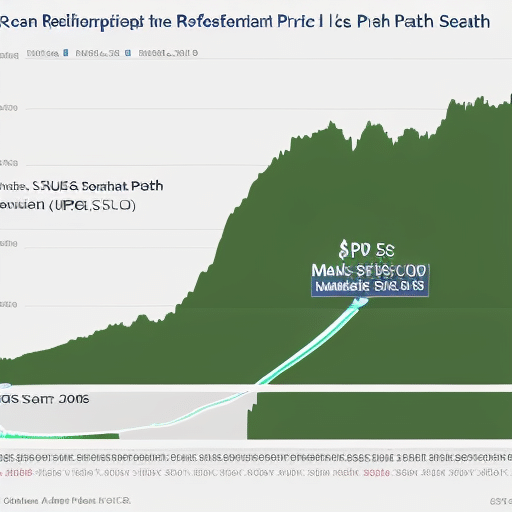Xrp Historical Price Data
XRP, more commonly known as Ripple, is a cryptocurrency that has experienced significant price fluctuations over the past few years. As a result, it can be useful to examine historical XRP price data in order to understand the factors that influence its value. This article will explore XRP’s historical performance, key events that have impacted its price, predictions for future values, and factors that impact the currency’s worth. Additionally, this article will also cover what RippleNet is and how analyzing XRP price charts can help investors make informed decisions. With all this information in hand, readers should feel more informed when it comes to making investment decisions regarding XRP.
Historical Price Performance
The historical performance of XRP, a cryptocurrency associated with the Ripple payment network, has seen multiple transitions in its price over time. From its inception up until 2017, the price of XRP was relatively stable and saw gradual increases throughout that period. However, since 2017 there have been more dramatic fluctuations in the market value of XRP as it experienced both significant gains and losses. This volatility has continued through 2020.
Price Performance up to 2017
Amidst a turbulent market, XRP demonstrated resilient price performance up to 2017. As a cryptocurrency, Ripple was among the first to be developed and has since established itself as one of the leading digital assets in the industry. Despite competition from Ethereum and other blockchain-based projects, Ripple was able to maintain its position through strategic partnerships and aggressive marketing campaigns.
Ripple’s success can be attributed to its ability to leverage existing financial systems, while also providing cutting-edge technology for cross-border payments. The company had several key advantages over its competitors:
-
Superior Technology: Ripple’s technology allowed for faster transaction speeds than Ethereum or Bitcoin which increased liquidity in the crypto markets. This enabled Ripple to quickly become a go-to solution for banks and businesses looking for a reliable global payment option.
-
Strategic Partnerships: To solidify their presence in the crypto space, Ripple formed strategic partnerships with several major financial institutions such as American Express, Santander Bank, UBS Group AG and Japan’s SBI Holdings. These alliances gave them access to resources that allowed them to further develop their platform and increase adoption of their cryptocurrency.
-
Aggressive Marketing Campaigns: To reach out to potential customers on an international scale Ripple launched an aggressive marketing campaign with events held around the world targeting influential figures in finance and tech startups. The combination of these factors meant that XRP was able to remain competitive despite growing competition from new entrants into the market up until 2017 when it saw significant gains due largely in part by speculation about new use cases for blockchain technology across various industries. This set the stage for further growth from 2017 onwards into 2020 where XRP continues to make strides towards mainstream adoption as a digital asset used by individuals and institutions alike around the world..
Price Performance from 2017-2020
Positioned at the forefront of a rapidly evolving market, Ripple has achieved success in maintaining its prominence from 2017 to 2020. This is due largely to the efforts of the team behind Ripple and their ability to successfully capitalize on crypto adoption while also managing supply dynamics. In addition, strategic collaborations with financial institutions have been instrumental in increasing liquidity for XRP tokens and stimulating demand for them in the market. This has led to an increase in price performance despite some volatility during certain periods. The overall effect has been an impressive growth trajectory from 2017-2020, with XRP firmly established as one of the most prominent digital currencies available today. As such, it is clear that Ripple’s strategies have paid off and resulted in a healthy outlook going into 2021. With this context in mind, it is worthwhile exploring key events that influenced XRP’s price over this period.
Key Events that Influenced XRP’s Price
The discussion of key events that have influenced XRP’s price is an important one. Ripple has been embroiled in a lawsuit with the U.S. Securities and Exchange Commission since late 2020, which has had a significant impact on the token’s price performance. Additionally, several major crypto exchanges have de-listed XRP from trading, further negatively affecting its value. During the 2021 bull run, XRP was largely left out of the major price increases seen by other tokens, leading to further drops in its overall value.
Ripple and the SEC Lawsuit
In late 2020, Ripple Labs faced allegations from the U.S. Securities and Exchange Commission regarding its sale of XRP tokens. This lawsuit had a major impact on both Ripple and the cryptocurrency market as a whole. The following table outlines some of the implications that this lawsuit had for Ripple and the SEC:
| Impact | Implication | Ripple | SEC |
|---|---|---|---|
| Costly Litigation | High legal costs incurred | Increased regulatory oversight | |
| Uncertainty | Loss of investor confidence | Heightened uncertainty in crypto markets | |
| Regulatory Crackdown | Possible fines or penalties imposed by SEC | Further efforts to limit unregulated investors |
The implications of this lawsuit continue to reverberate throughout the industry, making it difficult to predict what will come next. With this in mind, it is clear that the ripple effect of this case has been far-reaching, with significant implications for both Ripple and the SEC alike. Transitioning away from this topic, de-listing from major crypto exchanges further impacted XRP’s price due to decreased liquidity…
XRP’s De-listing from Major Crypto Exchanges
A major consequence of the Ripple and SEC lawsuit was XRP’s de-listing from many prominent crypto exchanges, leading to decreased liquidity and market access. This decrease in liquidity has had an adverse effect on XRP’s value relative to other altcoins competing for market share in the cryptocurrency space. The speculation surrounding the legal proceedings against Ripple also caused increased volatility for XRP, causing traders to become wary of investing in it and instead look towards more stable coins like Bitcoin or Etherium. Additionally, this uncertainty around XRP’s future led investors to look for opportunities with other altcoins that offered better returns than expected from XRP. As a result, XRP has faced increased competition from newer altcoins which have been able to capitalize on its decreased liquidity due to its de-listing from major exchanges.
XRP’s Performance During the 2021 Bull Run
Rising to prominence amidst a 2021 bull run, XRP experienced unprecedented growth in the cryptocurrency market. With Ripple’s impact and its capacity for quick transactions, the token has become one of the most sought after digital assets among investors; however, XRP’s volatility makes predicting its value an uncertain affair. The coin had a strong start to the year, with prices reaching highs of over $0.90 USD in mid-April; however, since then it has seen a steady decline, with prices currently hovering around $0.50 USD. This is likely due to a combination of factors such as increased regulations and competition from other cryptocurrencies on the market. Despite this decline in value, XRP remains one of the top five crypto assets by market capitalization and still holds promise for potential gains as more institutional investors enter into the space. As such, many analysts are optimistic about XRP’s future performance despite current market conditions.
XRP Price Predictions
Considering the past trends of XRP prices, it is possible to make informed predictions about its future value. Analyzing the historical performance of XRP relative to other altcoins can provide insight into how well it might perform in comparison. Additionally, assessing scalability issues related to XRP transactions and software upgrades can help determine whether it is a viable investment. It is also important to consider factors that impact XRP’s price when predicting its future value.
Factors such as market sentiment, news events, and technological advancements all have an influence on the cryptocurrency landscape and need to be taken into account when making an informed prediction regarding XRP’s future performance. Additionally, understanding the differences between various exchanges and their impact on trading volume helps investors understand how their chosen exchange could affect pricing trends for cryptocurrencies like XRP. With this knowledge of past trends and current factors at play in mind, investors can make more reliable predictions about the future of this digital asset.
Factors that Impact XRP’s Price
Analyzing the complex array of factors that affect the value of XRP can help investors develop a better understanding of its potential trajectories. Variables such as subsidiary partnerships and institutional investments have been identified as influential elements that impact the cryptocurrency’s performance. Subsidiary partnerships with companies like MoneyGram and RippleNet are important because they allow for increased circulation and use cases, which typically increases demand for XRP tokens. The influx of institutional investors into the digital currency market has also led to higher valuations since larger organizations often invest in assets with more established track records. Therefore, when assessing an investment in XRP, it is prudent to consider both these factors and their potential effects on price movements. With this knowledge, investors can make more informed decisions about their holdings. Moving forward, it is essential to gain a better understanding of what Ripplenet is in order to grasp how its functionality further impacts XRP’s worth.
What is RippleNet?
RippleNet is a blockchain-based payment system developed by Ripple Labs that enables faster, more secure, and cost-effective payments across borders. How does this technology influence XRP’s value? RippleNet has become increasingly popular among financial institutions since its launch in 2012 due to its ability to facilitate international transactions quickly and securely. This has resulted in numerous ripple partners joining the network and using XRP tokens for cross-border payments. This increased demand in XRP tokens has driven up the token’s price as well as its utility. Furthermore, RippleNet provides access to a global network of banks and payment providers which helps remove barriers between different currencies, making it easier for customers to make real-time payments without having to worry about exchange rates or liquidity issues. As such, RippleNet can be seen as an important factor influencing the value of XRP tokens. The technology also helps improve transparency within the financial sector while reducing transaction costs, thus increasing overall efficiency while encouraging further adoption of XRP tokens into existing banking infrastructure.
This use case demonstrates how RippleNet contributes to the utilization of XRP tokens and highlights how this technology influences the token’s value on a macro level. Analyzing these factors can help investors better understand the dynamics behind XRP’s price movements, providing valuable insights into when they should buy or sell their investments for maximum return on investment (ROI).
Analyzing XRP Price Charts
RippleNet is a decentralized global payments network powered by the digital asset XRP. This technology has enabled banks and institutions to move money more efficiently, quickly, and cost-effectively on a global scale. In order to assess the implications of RippleNet’s adoption, it is important to analyze XRP price charts. By studying these charts, investors can gain insight into how RippleNet’s adoption has impacted the value of XRP over time.
In particular, bank adoption has had an impact on the price of XRP. Banks that have adopted RippleNet have increased demand for XRP and caused its price to rise as more financial institutions leverage its capabilities in international transactions. In addition, automated trading bots are utilizing machine learning algorithms to buy and sell large amounts of XRP at once, which can also drive up the price in certain cases. Ultimately, by analyzing historical price data for XRP investors can better understand not only how this cryptocurrency behaves but also how its adoption impacts market dynamics.
Frequently Asked Questions
What is the current price of XRP?
Market analysis of XRP suggests that its current price is subject to future trends and speculative activity. Careful evaluation of macroeconomic conditions and technical indicators can help to identify potential price movements.
How has XRP’s market cap changed over time?
The buying signals and market trends of XRP can be seen as a roller coaster over time, with ups and downs in the market cap. To illustrate, in October 2020, the market cap nearly doubled within a 48 hour period. This emphasizes how quickly XRP’s market cap has shifted and is indicative of its volatile nature.
Is XRP a good investment?
Investing in XRP comes with financial risks, such as potential losses due to changes in regulations or market volatility. It is important to consider these factors before deciding whether it is a good investment choice for any individual.
How can I buy XRP?
One example of buying XRP is through an exchange such as Coinbase. Exchange options offer a range of buying methods, including bank transfers, credit cards and digital wallets that allow users to purchase XRP with fiat currencies or other cryptocurrencies. Users must research which exchanges are available in their region and evaluate the fees associated with each one.
How do I store XRP safely?
To securely store XRP, it is important to implement stringent security protocols and explore various storage solutions. Carefully consider factors such as safety features, convenience of use, and ease of access when selecting a suitable solution.






 Bitcoin
Bitcoin  Ethereum
Ethereum  Tether
Tether  XRP
XRP  Solana
Solana  USDC
USDC  TRON
TRON  Dogecoin
Dogecoin  Lido Staked Ether
Lido Staked Ether  Cardano
Cardano  Wrapped Bitcoin
Wrapped Bitcoin  Hyperliquid
Hyperliquid  Bitcoin Cash
Bitcoin Cash  Wrapped stETH
Wrapped stETH  Sui
Sui  Chainlink
Chainlink  LEO Token
LEO Token  Avalanche
Avalanche  Stellar
Stellar  USDS
USDS  Toncoin
Toncoin  Shiba Inu
Shiba Inu  WETH
WETH  Litecoin
Litecoin  WhiteBIT Coin
WhiteBIT Coin  Wrapped eETH
Wrapped eETH  Hedera
Hedera  Binance Bridged USDT (BNB Smart Chain)
Binance Bridged USDT (BNB Smart Chain)  Monero
Monero  Ethena USDe
Ethena USDe  Bitget Token
Bitget Token  Polkadot
Polkadot  Coinbase Wrapped BTC
Coinbase Wrapped BTC  Uniswap
Uniswap  Aave
Aave  Pepe
Pepe  Pi Network
Pi Network  Dai
Dai  Ethena Staked USDe
Ethena Staked USDe  Aptos
Aptos  OKB
OKB  Bittensor
Bittensor  BlackRock USD Institutional Digital Liquidity Fund
BlackRock USD Institutional Digital Liquidity Fund  Jito Staked SOL
Jito Staked SOL  NEAR Protocol
NEAR Protocol  Internet Computer
Internet Computer  Cronos
Cronos  Ethereum Classic
Ethereum Classic  Ondo
Ondo